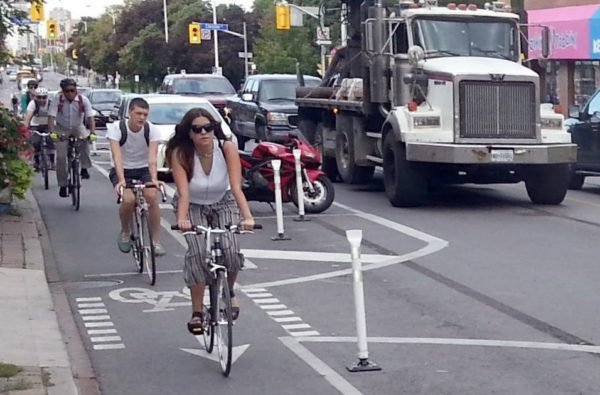
Mayor John Tory may be quite confident nowadays that he would sail into a smooth victory in the October mayoral elections given the fact that his former biggest threat, Doug Ford, is now the newly sworn-in Premier of Ontario. Not so fast, Mayor Tory! Gun violence and homicides on the streets of Toronto have recently shot up at alarming rates with no signs of improvement. Meanwhile, accidents and pedestrian/cyclist deaths on Toronto roads have become constant headlines in the news. Let’s leave gun violence and homicides for discussion on another post and focus on the subject of road safety today.
Ever since Vision Zero, a plan announced in 2016 to reduce traffic deaths to zero by 2022, casualties and injuries on the road have not become any better. So far in 2018 (and we’re only half way through the year), four cyclists and 19 pedestrians have been struck and killed, according to data compiled by The Toronto Star. In 2017, four cyclists and 40 pedestrians died. Since the Toronto council has approved Vision Zero two years ago, almost 100 pedestrians and cyclists have died.
Transport Canada data also shows an alarmingly consistent trend: more seniors have died in traffic fatalities than any other age group across Canada, from 2000 to 2015. Over that 16-year time span, seniors accounted for an average of 447 deaths per year. These numbers include several groups on the road – drivers, passengers, pedestrians, cyclists and motorcyclists.
Earlier this year, Statistics Netherlands also published the annual road fatalities and the fact that “cycling is deadlier than driving.” Two-thirds of the cycling deaths were people over 65 years of age. More people have been cycling in the Netherlands, especially the elderly. Statistics Netherlands compared the distance cycled per person per day in 2016 with the number of fatalities in 2017 per age group. The statistics make very clear that there should be extra attention to the over 65-year-olds and their increased risk when cycling.
Although there were no similar statistics in Canada indicating that more older people are now cycling on the road, one can assume that with improved longevity rates in recent decades, healthy seniors are more likely to ride their bicycles to get around town in major cities across Canada. All the more reasons to look at the Netherlands as a role model for road and cycling safety.
In 2016, older citizens bore the brunt of a record-breaking 12 months for pedestrian deaths in Toronto. According to The Toronto Star, 2016 was the deadliest for the city’s pedestrians in more than a decade, with 43 people killed by drivers. That’s the highest death toll since at least 2005, the oldest year on record in data recently released by the city.
The figures show that 2016 also saw the highest number of older people killed on the streets in a decade. Thirty-seven of the victims, or 86 percent, were over 55, which is the age the city’s road safety plan uses to define “older adults.” The demographic makes up about a quarter of the population. The Star also pointed out that although older people regularly account for a disproportionate number of traffic injuries, the percentage of deaths for those older than 55 was the highest in a single year since at least 2005. People aged 65 and older made up 67 percent of victims in 2016. Seniors advocacy group, CARP, said that with the city’s older population set to double to 1.2 million in the next 25 years, the city really has to examine what it is going to do in Toronto to make life safer for an aging population. That’s why Vision Zero was born in the same deadly year.
According to the Vision Zero website, between 2005 and 2016, there were 869 seniors killed or seriously injured in a collision with a motor vehicle. Special consideration will be given at locations exhibiting killed or serious injury collisions where there are higher concentrations of senior pedestrians living and interacting. These areas will be prioritized and targeted for speed reductions, increased walk times at traffic signals, enhanced pavement markings, “Watch Your Speed” driver-feedback signs and police enforcement for aggressive driving behaviours that affect senior pedestrians.
Over hardly 24 hours two weeks ago, Toronto police announced that a cyclist had been killed by a person driving a large truck; a pedestrian had been killed by a driver who fled; and another cyclist, who was hit in May, had died. In another incident a few days later, a motorcyclist was hit and killed by a person driving a sedan, who then fled.
On June 15, 2018, Mayor John Tory directed staff to draw $13 million from the city’s $260 million 2017 budget surplus to add more road safety signs, red light cameras, and infrastructure in 2018. Last week, in response to this crisis, Toronto city council increased that amount further to $22 million, bringing the Vision Zero budget to $43.3 million for 2018 and a total of $109 million over five years. However, I agree with Patricia Wood, York University professor, who said that while council has voted several times to speed up implementation and increase the budget, city councilors might not have understood what Vision Zero is about. Professor Wood said that Vision Zero isn’t about changing behaviour through corrective measures in terms of guilt. “It’s about redesigning the streets and enforcing that road design so it’s easy to understand and conflicts don’t arise,” she said.
It’s encouraging that according to the mayor, the additional money approved for Vision Zero would include funding for physical changes to the kind of street that experts say are necessary to get drivers to slow down.
Examples of improvements Mayor Tory listed included a doubling of this year’s planned increase of leading pedestrian intervals, which allow those on foot to get a head start at intersections, speeding up of spending on road redesign and a clearing of the backlog for installing speed bumps. Other changes could include repainting at intersections and enhancing bicycle lanes to add visibility.
The mayor, however, should perhaps look at good examples from other Canadian cities like Montreal. According to The Globe and Mail, Montreal has just approved funding for 33 kilometres of new bike lanes, to add to 846 they already have, 350 of which are totally separate from car traffic. They are going to eliminate parking spots to build the new ones. Meanwhile, in Toronto, we only have 37 kilometres of separate, protected bike lanes. Instead of the proposed moves so far which simply aim to manage Toronto drivers’ dominance of the road, Vision Zero in Toronto should focus more on redesigning the streets and increasing car-free bike lanes to introduce true sharing of the city among drivers, pedestrians and cyclists. Only then will we feel safer on the road!










